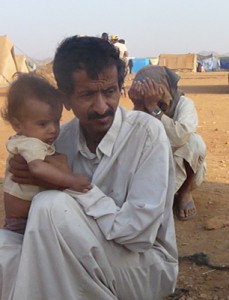October 21, 2010
A Humanitarian Response Index (HRI) team visited Yemen in June 2010. The mission featured the participation of Dubai Cares, the UAE-based philanthropic, and examined how the international donor community responded to the crisis. Yemen has some of the worst vital indicators amongst the least developed countries and is heading towards a worsening humanitarian crisis. Protection of civilians and the respect for basic human rights were two key issues.
| The field mission Dates: 4-11 June 2010 Team: David Bassiouni (Team leader) Fernando Espada and Nahla Haidar. |
Sudden massive displacement and growing refugee population
The humanitarian crisis in Yemen is an under reported and underpublicized one. Since 2004, the Government has been caught in a civil conflict in the north with the Houthi group. As the clashes escalated and intensified, serious protection concerns for the civilian population arose. In 2009, the conflict caused the sudden displacement of over 300,000 people in the short span of two months. Current estimates indicate 350,000 IDPs, including those displaced by previous rounds of fighting. In addition, an increasing number of Somalis are seeking asylum in Yemen, thereby adding to the current caseload of 100,000.
The conflict has taken a disproportionate toll on civilians leading to widespread humanitarian crisis. Both sides of the conflict have inflicted untold atrocities on civilians and violated basic human rights. Infrastructure and property have been severely damaged. There are fears that a lack of a comprehensive peace agreement will lead to further turmoil.
Growing needs and beneficiaries
Donors in Yemen are preoccupied with a development agenda amidst the worsening security and humanitarian crisis. The challenge is to influence the adoption of a two-pronged approach that highly prioritizes response to the humanitarian crisis while simultaneously continuing development efforts in parts of the country that are stable and ready to engage.
Other key challenges include: growing needs and beneficiaries, critical underfunding, lack of preparedness and response capacity, constrained humanitarian access limiting the flow of humanitarian assistance across the lines of belligerency, and an unstable security situation violating basic humanitarian rights.
Response
The massive displacements and the large refugee caseload took the government, the donor community and the international aid organizations by surprise. They were not fully prepared to meet the overwhelming challenges posed by the daunting number of IDPs and refugees. There was a lack of action on the part of the international community to recognize the importance of early warning, contingency planning and preparedness for the next crisis, as well as a lack of overall coordination of humanitarian assistance. Nevertheless, the Gulf countries compared well in performance against their OECD/DAC counterparts, especially in responding to needs. However, they were not so strong on transparency and accountability.

Share this